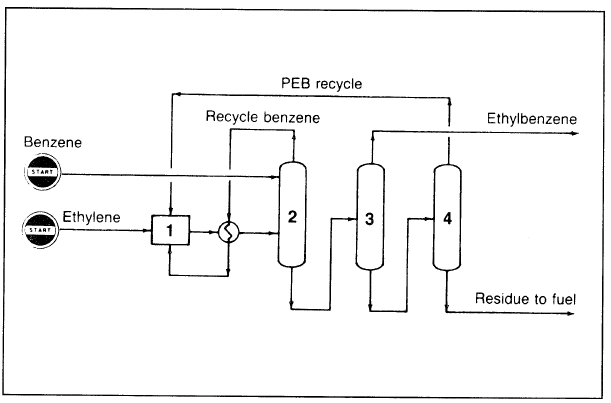
Ethylbenzene
 المؤلف:
sami matar & Lewis. F. Hatch
المؤلف:
sami matar & Lewis. F. Hatch
 المصدر:
Chemistry of PETROCHEMICAL PROCESSES
المصدر:
Chemistry of PETROCHEMICAL PROCESSES
 الجزء والصفحة:
p 265
الجزء والصفحة:
p 265
 10-9-2017
10-9-2017
 2240
2240
Ethylbenzene
Ethylbenzene (EB) is a colorless aromatic liquid with a boiling point of 136.2°C, very close to that of p-xylene. This complicates separating it from the C8 aromatic equilibrium mixture obtained from catalytic reforming processes. Ethylbenzene obtained from this source, however, is small compared to the synthetic route.
The main process for producing EB is the catalyzed alkylation of benzene with ethylene:

Many different catalysts are available for this reaction. AlCl3-HCl is commonly used. Ethyl chloride may be substituted for HCI in a molefor- mole basis. Typical reaction conditions for the liquid-phase AlCl3 catalyzed process are 40–100°C and 2–8 atmospheres. Diethylbenzene and higher alkylated benzenes also form. They are recycled and dealkylated to EB.
The vapor-phase Badger process (Figure 1.1), which has been commercialized since 1980, can accept dilute ethylene streams such as those produced from FCC off gas. A zeolite type heterogeneous catalyst is used in a fixed bed process. The reaction conditions are 420°C and 200–300 psi. Over 98% yield is obtained at 90% conversion.4,5 Polyethylbenzene (polyalkylated) and unreacted benzene are recycled and join the fresh feed to the reactor. The reactor effluent is fed to the benzene fractionation system to recover unreacted benzene. The bottoms containing ethylbenzene and heavier polyalkylates are fractionated in two columns.

Figure 1.1. The Badger process for producing ethylbenzene: (1) reactor, (2) fractionator (for recovery of unreacted benzene), (3) EB fractionator, (4) polyethylbenzene recovery column.
The first column separates the ethylbenzene product, and the other separates polyethylbenzene for recycling. An optimization study of EB plants by constraint control was conducted by Hummel et al. They concluded that optimum operation could be maintained through a control system when conditions such as catalyst activity and heat transfer coefficients vary during operation.
Ethylbenzene is mainly used to produce styrene. Over 90% of the 12.7 billion pounds of EB produced in the U.S. during 1998 was dehydrogenated to styrene.
 الاكثر قراءة في البترو كيمياويات
الاكثر قراءة في البترو كيمياويات
 اخر الاخبار
اخر الاخبار
اخبار العتبة العباسية المقدسة


